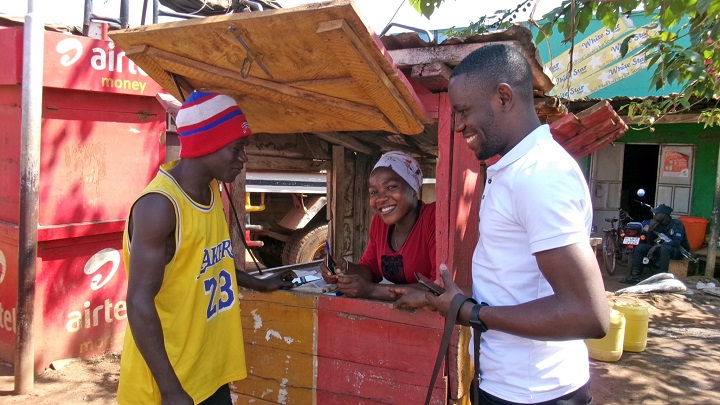Research Fellow Komasawa Makiko Investigates the Outcomes of the Implementation Phase of the Research Project “Intervention Study on Unintended Teenage Pregnancy in Uganda”
2024.11.29
In Sub-Saharan Africa, about half of the population is under the age of 20 (World Population Prospects, United Nations, 2022) and cases of unintended pregnancy are increasing among adolescents, the bearers of the future. Unintended pregnancy in adolescence can have lifelong consequences for health and wellbeing, for example when girls develop perinatal health issues or have to drop out from school. Research Fellow Komasawa Makiko
of the JICA Ogata Sadako Research Institute for Peace and Development (JICA Ogata Research Institute), and her colleagues are working on a research project “Intervention Study on Unintended Teenage Pregnancy in Uganda
” to address this problem in collaboration with Busoga Health Forum, a local NGO in Uganda.
This study aims to increase awareness of sexual and reproductive health and rights (SRHR) and the uptake of contraceptives among unmarried teenagers in Uganda. Using the mobile money shops (vendors) that local adolescents are familiar with, teenage customers can be provided with condoms and information on SRHR and can be referred to healthcare facilities when further necessary services are required. This novel concept increases their ability to access healthcare services.
A baseline study was conducted between February and March 2024 to identify the current level of knowledge and awareness as well as the behavior relating to SRHR among Ugandan adolescents. After that, an intervention study was implemented from May to August. To check the effectiveness of intervention and to prepare for the following endline study, Komasawa visited Uganda in September 2024.

A female vendor provides information on sexual and reproductive health and rights (SRHR) to a teenager.
At a workshop with 30 vendors who participated in the intervention study, feedback on the outcomes and the local changes observed was gathered. Reflecting on this workshop, Komasawa noted that the local people gradually understood that the vendors who provided health services were effectively “musao,” meaning “healthcare worker” in the local language and deserved greater respect. What struck her most was that the vendors were also empowered through this social participation. Komasawa added that some vendors reported other impacts such as teachers from nearby schools visiting the vendors, gathering SRHR information and educational materials, and then beginning SRHR education at their schools.
Furthermore, the intervention study with vendors showed that the rate of condom usage among teenagers was steadily growing and some reported that no more unintended pregnancies were being seen in their local area. According to the daily data recorded by the 30 vendors, the cumulative number of teenage customers was approximately 110,000 over the four months. Of these, approximately 40,000 collected information on the SRHR and nearly 90,000 condoms were dispensed (Note: these are all preliminary figures).
In Uganda, public healthcare facilities offer contraception services for free but cannot be accessed easily as their numbers are limited. In addition, counseling or an interview with a healthcare worker that goes into personal details is required before receiving SRHR services at these facilities. As a consequence, unmarried teenagers feel that access is too difficult and tend to hesitate to use these services. Komasawa recognized that the new approach was effective among adolescents as it allows them to get necessary information and condoms within walking distance from home, from vendors they are familiar with, and all the while having their privacy protected. Their parents’ generation were also grateful although they showed disapproval in the beginning.
Komasawa reported on the progress of the study to Dr. Richard Mugahi, Commissioner in charge of Reproductive and Infant Health, Ministry of Health of Uganda. The ministry is working on guidelines to prioritize adolescent health in district-level development plans and showed a great interest in the design of this study. This is because the new vendor-based design, which focuses on local resources and is co-developed with the private sector, is in line with the philosophy of the guidelines. To be able to further expand it to other districts in Uganda, the JICA Ogata Research Institute’s study team will continue to communicate closely with the Ministry of Health and scale-up this program further as time goes on.
Komasawa Makiko (on the right) reports on the progress of the study to Dr. Richard Mugahi, Commissioner in Charge of Reproductive and Infant Health, Ministry of Health of Uganda.

A researcher (on the right) conducts the endline study targeting adolescents that started in September 2024.
Komasawa commented that to quantitatively validate the effectiveness of the study as a whole, we need to wait for the results of the endline survey that started in late September 2024. However, she is very confident that the results will be positive. Further, by widely expanding this program to other districts in Uganda in the future, she aspires to contribute to the progress of Goal 3 (good health and well-being), Goal 4 (quality education) and Goal 5 (gender equality) of the Sustainable Development Goals (SDGs) that should be met by 2030. In addition to being submitted as a policy recommendation to the Ugandan government, the outcomes of this study will be presented at international academic conferences and submitted as academic papers for publication.

事業事前評価表(地球規模課題対応国際科学技術協力(SATREPS)).国際協力機構 地球環境部 . 防災第一チーム. 1.案件名.国 名: フィリピン共和国.

事業事前評価表(地球規模課題対応国際科学技術協力(SATREPS)).国際協力機構 地球環境部 . 防災第一チーム. 1.案件名.国 名: フィリピン共和国.

事業事前評価表(地球規模課題対応国際科学技術協力(SATREPS)).国際協力機構 地球環境部 . 防災第一チーム. 1.案件名.国 名: フィリピン共和国.

事業事前評価表(地球規模課題対応国際科学技術協力(SATREPS)).国際協力機構 地球環境部 . 防災第一チーム. 1.案件名.国 名: フィリピン共和国.

事業事前評価表(地球規模課題対応国際科学技術協力(SATREPS)).国際協力機構 地球環境部 . 防災第一チーム. 1.案件名.国 名: フィリピン共和国.
scroll